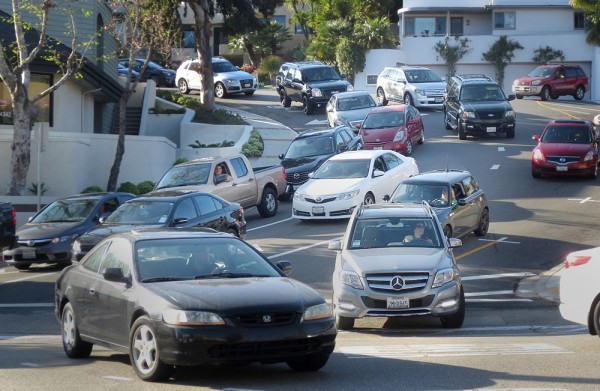Just when you thought it might be safe to venture out in your vehicle again, another major road project in Laguna Canyon begins next week and is expected to slow traffic even more along an already congested thoroughfare into Laguna Beach.
Construction to bury overhead utilities on Laguna Canyon Road begins Monday, April 4, with 10 ½ weeks of bulldozers cutting and digging trenches at Big Bend, a curve in the canyon road two miles from Coast Highway, Mark Trestik, assistant city engineer, told the City Council last week.

The road work comes on the heels of a sewage pipe replacement project that started in October and closed the busy and steep Third Street hill for nearly 10 weeks. The hill connects hilltop neighborhoods to the downtown, Laguna Canyon Road and Coast Highway, the only two roads in and out of town. It will not be fully reopened until the end of the month with intermittent closures in April.
“What we’ve gone through with the Third Street hill is just a disaster,” said Mayor Steve Dicterow, “and this is going to be worse.”
Trenching is the first step to remove overhead utility poles at Big Bend, a $1.3 million project intended to reduce fire risk while improving aesthetics along the canyon road. The curve was selected as the first section to tackle due to the number of vehicles colliding with poles there, City Manager John Pietig said. Southern California Edison is funding and managing the project due to the potential danger of a high concentration of overhead electric wires and poles on a heavily traveled road, according to a city report.
Holes will be cut in the outbound lane and along 1,600 feet in front of Langlois Foods, Victoria Skimboards and several other businesses there, Trestik said. Vaults will be inserted into the holes and cables and other electrical equipment installed for future underground connections.
Traffic will continue to travel in both directions but outbound vehicles will be redirected to the center turn lane while trenches are cut on the current outbound lane, said Trestik. The inbound lane on Laguna Canyon Road will remain unimpeded except for one week when only one lane will be open at night with flagmen directing traffic, he reported.
All 11 utility poles on the business side of the road at Big Bend will eventually be removed, but four high-voltage metal transmission poles on the other side will remain, said Trestik. The transmission poles carry electrical signals from the power plant to substations and are difficult and expensive to underground due to the high-voltage, he said. Because the poles are metal, they’re not considered a fire hazard, Trestik said.
With only two roads in and out of town, the trenching at Big Bend will begin at 9 a.m. and stop each day by 3 p.m. to accommodate commuter traffic. Road work will stop by June 15 for the summer season and commence again in September, Trestik reported. Laguna, a town of 23,000 residents, sees 6 million visitors a year.
There’s no good time for a street project in Laguna, said Pietig. Projects restricting traffic are scheduled consecutively and spread out over 12 to 24 months to avoid creating congestion in more than one area, he said. “We know there will be some complaints,” Pietig said.
“Here’s my standard,” Dicterow said. “If I can walk from one end of town to the other faster than you can drive, that’s not good.”
The second phase of the Big Bend project entails work outside of the roadway, undergrounding private connections and electrical equipment and lastly removing poles and wires, said Trestik. This phase is expected to continue until mid-2017 with little or no impact on Laguna Canyon Road traffic, he said.
The report on the Big Bend undergrounding project reviewed last week has been delayed for a year due to questions regarding the cost and breadth of the project and to complete other street projects.
Funding taps a $2.8 million account for undergrounding accrued through credits from Edison and a Public Utilities Commission tariff. The project will be managed by Southern California Edison, and includes equipment from Cox Communications, Verizon and ExteNet cellular systems, said Todd Pearce, project director for Edison.
Edison provides money to cities for undergrounding utilities in locations where there’s a heavy concentration of overhead communications equipment near a busy road, according to Christina Templeton, city engineer and interim director of public works.
If traffic congestion proves insurmountable, the council directed the city to go to Plan B and have crews work at night to expedite the process. Pearce said Edison would switch to a 7 p.m.-6 a.m. schedule if needed. Night work is preferable, said Pietig, although more expensive and noisy, which will affect 10 nearby residences.





I know the designers are professional with engineering licenses and construction planing experience. I just wonder since it has been a few years since we have seen rain, can anyone tell me if the drainage problem has been resolved particularly for the “Big Bend” section of Laguna Canyon ?
[…] of underground utilities on Laguna Canyon road this past Monday. As the LB Indy put it: “Just when you thought it might be safe to venture out in your vehicle again, another major road proj…” And Mayor Steve Dicterow’s comment, “What we’ve gone through with the […]
[…] said he and his committee support the survey’s high-ticket item of undergrounding […]